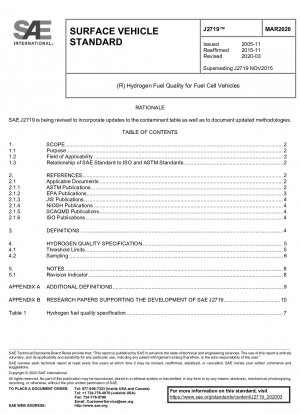SAE J2719-2020
Information Report on the Development of a Hydrogen Quality Guideline for Fuel Cell Vehicles
- Standard No.
- SAE J2719-2020
- Published By
- SAE - SAE International
- Latest
- SAE J2719-2020
- Scope
- This Information Report provides interim background information and an interim specification of hydrogen fuel quality for commercial proton exchange membrane (PEM) fuel cell vehicles. This Report also provides background information on how this interim specification was developed by the Hydrogen Quality Task Force (HQTF) of the Interface Working Group (IWG) of the SAE Fuel Cell Standards Committee. The constituents and thresholds listed in Table 1 are based on a survey of the industry@ the published literature and reflects current and draft analytical test methods. Some of the allowable constituent levels are higher than desired because a published detection method is not available for the desired threshold. Some of the allowable constituent levels may be lower than desired due to incomplete evaluations and/or an attempt to minimize testing costs (such as including methane in total hydrocarbons). Additional testing of the effects of impurities on fuel cells@ fuel systems@ and storage media is required. Furthermore@ development is required on suitable@ cost effective test methods@ sampling methodologies and equipment for laboratory@ in-line and field evaluation. The American Society of Testing and Materials (ASTM) D03 (Gaseous Fuels) Committee has been charged to address some of these issues. Purpose The purpose of this hydrogen fuel quality specification guideline is to provide a common hydrogen fuel quality specification for all US commercial hydrogen refueling stations for fuel cell vehicles (FCVs) and hydrogen internal combustion engine vehicles (ICEVs). Hydrogen quality is defined as being measured at the dispenser nozzle using a suitable adapter and methodology developed by ASTM D03 (Gaseous Fuels) Committee. Field of Applicability The hydrogen quality guideline presented in this Information Report is applicable to PEM FCVs at the point of interface between the fueling station and the vehicle. The specification of hydrogen quality is intended to meet the requirements of FCVs for near term demonstration vehicles@ and to meet the requirements of ICEVs to the extent that they have currently been determined. Information considered in the specification of the fuel quality includes: Applicable standard chemical analysis test methods to quantify the presence of identified H2 impurities Infrastructure sources of impurities and cost related to production@ distribution@ storage and handling of H2 Fuel cell systems@ specifically@ levels of impurities that adversely impact performance and/or durability On-board H2 storage and delivery systems Relationship of SAE Standard to ISO and ASTM Standards The guidelines and information presented in this SAE J2719 Information Report was brought to SAE for use in Table 1 and is coordinated with ISO TC197/WG12 (H2 Fuel ?C Product Specification Working Group) as well as the ASTM D03 (Gaseous Fuels) Committee and is consistent with ISO 14687 Part2.
SAE J2719-2020 history
- 1970 SAE J2719-2020 Information Report on the Development of a Hydrogen Quality Guideline for Fuel Cell Vehicles
- 0000 SAE J2719-201511
- 2015 SAE J2719-2015 Hydrogen Fuel Quality for Fuel Cell Vehicles
- 2011 SAE J2719-2011 Hydrogen Fuel Quality for Fuel Cell Vehicles
- 2008 SAE J2719-2008 Information Report on the Development of a Hydrogen Quality Guideline for Fuel Cell Vehicles
- 2005 SAE J2719-2005 Information Report on the Development of a Hydrogen Quality Guideline for Fuel Cell Vehicles
